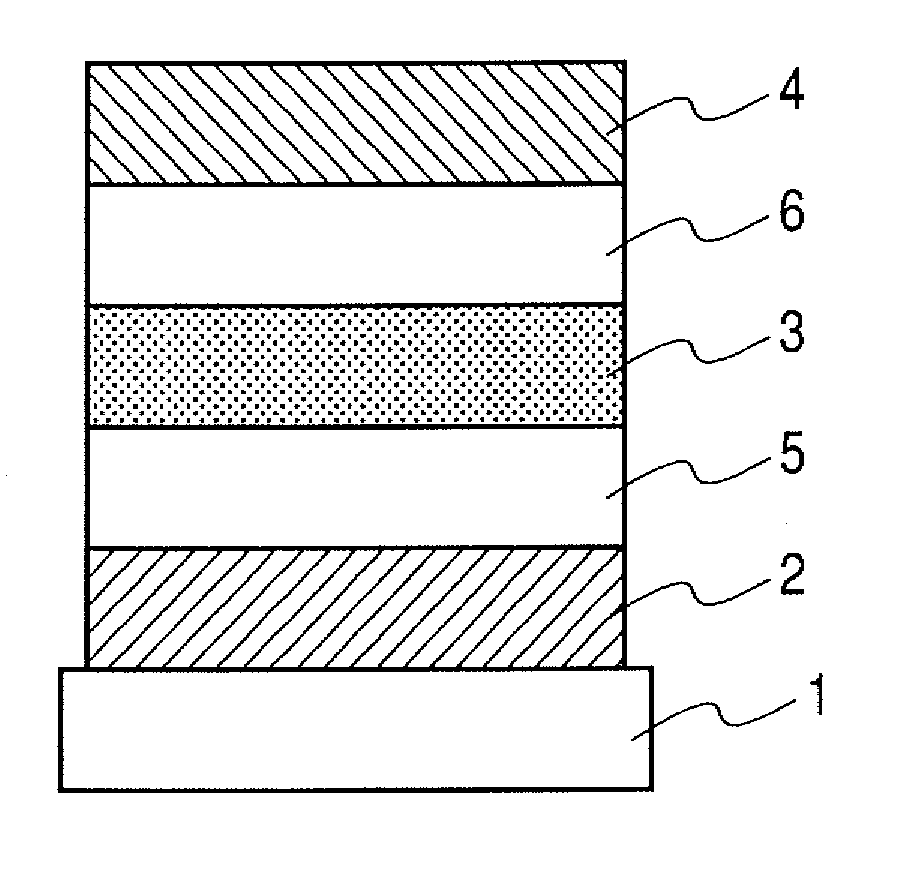Compound and organic light emitting device
a light-emitting device and organic technology, applied in the direction of solid-state devices, discharge tubes/lamp details, natural mineral layered products, etc., can solve the problems of large durability problems of organic light-emitting devices, and achieve high efficiency, high glass transition temperature, and high efficiency.
- Summary
- Abstract
- Description
- Claims
- Application Information
AI Technical Summary
Benefits of technology
Problems solved by technology
Method used
Image
Examples
example 1
Method of Producing Exemplified Compound No. 101
[0080]Exemplified Compound No. 101 of the present invention can be produced by, for example, the method to be described below.
(1) Synthesis of 9-(7-tert-butyl-3-methylpyren-1-yl)anthracene as Intermediate Compound 1
[0081]
[0082]Under a nitrogen atmosphere, 5 g (19.4 mmol) of 9-bromoanthracene and 7.73 g (19.4 mmol) of 2-(7-tert-butyl-3-methylpyren-1-yl)-4,4,5,5-tetramethyl-[1,3,2]dioxaborolane were dissolved in a mixed solvent of toluene (240 ml) and ethanol (120 ml). Further, an aqueous solution prepared by dissolving 3.93 g (38.8 mmol) of sodium carbonate in 40 ml of distilled water was added to the resultant, and the whole was stirred at 50° C. for 30 minutes. Tetrakis(triphenylphosphine)palladium (1.57 g, 1.36 mmol) was added to the resultant, and the whole was stirred under heat on a silicone oil bath heated to 90° C. for 3.5 hours. After the resultant had been cooled to room temperature, water, toluene, and ethyl acetate were adde...
example 2
[0091]An organic light emitting device having the structure illustrated in FIG. 3 was produced by the method described below.
[0092]First reference numerals of FIG. 3 will be described. There are provided a substrate 1, an anode 2, a light emitting layer 3, a cathode 4, a hole transporting layer 5, and an electron transporting layer 6.
[0093]Indium tin oxide (ITO) as the anode 2 was formed as a film having a thickness of 120 nm on a glass substrate as the substrate 1 by a sputtering method, and the resultant was used as a transparent conductive supporting substrate. The resultant substrate was subjected to ultrasonic cleaning in acetone and isopropyl alcohol (IPA) in the stated order. Then, the substrate was washed in boiling IPA and dried. The substrate was further subjected to UV / ozone cleaning to be used as a transparent conductive supporting substrate.
[0094]A chloroform solution containing 0.2 wt % was prepared by using Compound 3 represented by the following structural formula as...
example 3
[0102]A device was produced in the same manner as in Example 2 except that Compound 5 represented by the following structural formula was used instead of Compound 4 of Example 2. The device of this example was observed to emit light with a luminous efficiency of 4 lm / W at an applied voltage of 4 V. In addition, the device was observed to emit blue light having CIE chromaticity coordinates (x, y) of (0.15, 0.14) and a good color purity.
[0103]Further, a voltage was applied to the device under a nitrogen atmosphere for 100 hours. As a result, the device was observed to emit good light continuously.
PUM
| Property | Measurement | Unit |
|---|---|---|
| glass transition temperature | aaaaa | aaaaa |
| thickness | aaaaa | aaaaa |
| thickness | aaaaa | aaaaa |
Abstract
Description
Claims
Application Information
 Login to View More
Login to View More - R&D
- Intellectual Property
- Life Sciences
- Materials
- Tech Scout
- Unparalleled Data Quality
- Higher Quality Content
- 60% Fewer Hallucinations
Browse by: Latest US Patents, China's latest patents, Technical Efficacy Thesaurus, Application Domain, Technology Topic, Popular Technical Reports.
© 2025 PatSnap. All rights reserved.Legal|Privacy policy|Modern Slavery Act Transparency Statement|Sitemap|About US| Contact US: help@patsnap.com



